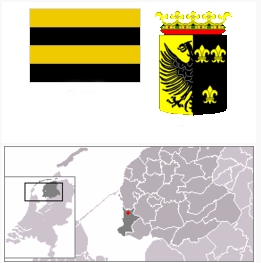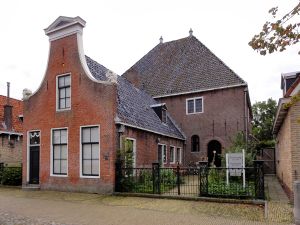Workum (Friesland, Netherlands)


Photo by A. J. (Ton) van der Wal, Rijksdienst voor het Cultureel Erfgoed.
Source: Wikimedia Commons.
Workum, a town in the Dutch province of Friesland (1953 population, 4,080, with 190 Mennonites; 2004 population, 4,162), with a Mennonite congregation (coordinates: 52° 58' 39" N, 5° 26' 42" E). The year of the origin of this congregation is unknown, but Anabaptists were found here at an early date. The martyr Claesken Gaeledochter was baptized "near Workum in the fields" in 1549. Both she and her husband Hendrik Eeuwesz were executed at Leeuwarden in 1559. Leenaert Bouwens baptized 23 persons at Workum in 1551-54, one in 1557, and 25 in 1563-65. In 1574 Hendrik Pruyt died at the hands of Spanish soldiers. At this time or shortly after, the Mennonites must have been rather numerous at Workum and soon they were leading in trade and shipping, then an important means of livelihood in this town. In 1578 when the town was liberated from the Spanish yoke, a Mennonite, Hemme Haucx (b. 1503), became a burgomaster of Workum, and three other Mennonites were in the town council; they were exempted from the oath. But as early as 1600 Calvinism became predominant at Workum, which was somewhat intolerant toward Mennonitism. In 1605 the Reformed pastor Johannes Bilt sharply attacked the Mennonites, and in 1608 the remodeling of the meetinghouse was forbidden. But soon relations between the magistrates and the Mennonites seem to have improved; no further trouble occurred.
There is some unclear information that there were three congregations at Workum ca. 1580, one High German, one Frisian, and one Waterlander, but only of the Waterlander church is there anything definitely known. This congregation, which in 1647 was represented at the Waterlander conference at Amsterdam, was divided by a schism, probably before 1600. A more conservative part of the congregation separated from the main, rather progressive body. This conservative group may have assumed the name of Frisian or High German. Each group had a meetinghouse; the progressives met at de Keet, a former salt works located on the site of the present meetinghouse, whereas the conservatives met in a private home, not far from de Keet. It is not known when and how this division ended, but the conservative group had disappeared at least by 1620. The preacher of the Keet congregation was a certain Eenke from about 1580; his son Rippert Eenkes was a preacher from ca. 1600 and soon after an elder, serving until after 1627. He was an influential Waterlander leader, who conducted services in a number of congregations as far away as Amsterdam, Haarlem, and Emden, and even in Danzig in Prussia. But in his home church his advanced ideas evoked much opposition and in 1618 he was suspended on a charge of misconduct, which was used to eliminate the powerful elder, beloved by many but undesirable for more. Many conferences were held to restore peace; in the meantime it became clear that the charge was false. Finally the Waterlander leader Hans de Ries, who visited Workum more than once, succeeded in 1620 in settling the dissensions. After the death of Eenkes the congregation continued until 1738 to choose their ministers from their own members. Usually there were three or four preachers, whereas baptism and communion services were led by elders from elsewhere.
In 1695 the Workum congregation was one of the founders of the Mennonite conference of Friesland (FDS). The ties with the Waterlanders in North Holland, which had been very strong in the early 17th century, were loosened. Workum was always a loyal and even leading member in the FDS, except in 1817, when it withdrew for a few months because it was dissatisfied with the subsidy policy of the conference, Workum also played an important role in the Zuiderklasse.
A new meetinghouse, spacious and well-built, was erected in 1695. This meetinghouse is still in use; in 1956-57 it was renovated, and rededicated 11 April 1957. The cost of the 1695 church had been about 5,100 Dutch guilders. Many members of the church were well-to-do businessmen in shipping, shipbuilding, lumbering, or lime-burning. The wealthiest citizens of Workum in the 17th and early 18th centuries, members of the Hinlopen, Roos, Molenaar, and de Hoop families, were Mennonites. These families all died out or had left Workum by the 19th century. In the 18th century the prosperity of the town declined, particularly because of the decline of Baltic Sea shipping. At the same time the prosperity and the membership of the Workum Mennonite congregation declined. The baptized membership, which is estimated at more than 400 ca. 1650, stood at 417 in 1692, 434 in 1703, 399 in 1715, and 325 in 1748, but from then there was a catastrophic decay: about 230 in 1762, ca. 190 in 1791, 74 in 1838, 70 in 1861; from then there was some increase: 97 in 1900, 114 in 1926, 112 in 1940, followed by a slight decrease in the last years. In 1958 the membership numbered 89.
In 1738 the first salaried minister, coming from outside, was Jan Cornelis Dam, who served at Workum 1738-82. He was followed by Sybren Hofstra 1782-1811, J. van Douwen 1811-25, S. J. van der Goot 1826, who was the first pastor of Workum educated at the Amsterdam Mennonite seminary, Jacob Oosterbaan 1827-39, J. H. Akkeringa 1839-73, J. Westerman Holstijn 1874-83, S. Wartena Jr. 1884-86, four years of vacancy, T. H. Siemelink 1890-1908, H. Westra 1908-11, J. Kooiman 1911-14, I. Hulshoff 1914-35, J. P. H. Grootes 1935-39, D. Richards 1940-44, G. de Groot 1944-48, R. Hofman 1950-54, and Miss M. J. van Hamel from 1954. Since 1942 the pastors of Workum have also been in charge of the small congregation of Koudum.
At the close of the 18th century peace was greatly disturbed in the Workum church by differing political views. Whereas the deacon Ruurd Wopkes sided with the Orangists (political party favoring the Prince of Orange and the established political order), many members, e.g., the merchant Jan Douwes de Hoop and particularly the pastor Sybren Hofstra, were Patriots; abandoning the principle of nonbearing of arms, they together with the non-Mennonite citizens organized a voluntary militia in 1785, and in 1787 tried (but in vain) to take possession of the city government. Thereupon Jan de Hoop's home was plundered and pastor Hofstra was suspended from his office 1787-95 by the city magistrates. In 1797 peace, both political and congregational, was restored. By the Napoleonic occupation and the financial measures of Napoleon the Mennonite congregation of Workum, formerly rather well-to-do, was greatly impoverished. The considerable legacy willed to the church by Simen Durk Hinlopen in 1795 was nearly all claimed as a compulsory state loan; in 1811 there were no funds to pay the pastor's salary. The financial situation was improved after 1815 by the generous gifts of its treasurer, J. J. Stelwagen, and a regular subsidy from the Algemeene Doopsgezinde Sociëteit from 1818.
Church activities in 1959 were: ladies' circle, youth group 18-25, and a Sunday school for children.
Bibliography
Cate, Steven Blaupot ten. Geschiedenis der Doopsgezinden in Friesland. Leeuwarden: W. Eekhoff, 1839: 89, 157, 169, 187, 188, 246, 248, 252, 806.
Doopsgezinde Bijdragen (1861): 144; (1873): 83, 90-103; (1888): 116; (1895): 179.
Hoop Scheffer, Jacob Gijsbert de. Inventaris der Archiefstukken berustende bij de Vereenigde Doopsgezinde Gemeente to Amsterdam, 2 vols. Amsterdam: Uitgegeven en ten geschenke aangeboden door den Kerkeraad dier Gemeente, 1883-1884: I, No. 663; II, Nos. 2348-51; II, 2, Nos. 652-71.
Siemelink, T. H. "Geschiedenis van de Doopsgezinde gemeente te Workum." Doopsgezinde Bijdragen (1899), (1903), and (1905):
Siemelink, T. H. Toespraak to commemorate the second centennial of the meetinghouse (n.p., n.d.-1895).
Additional Information
Congregation: Doopsgezinde Gemeente Workum
Address: Noard 100, 8711 AK | Workum, Netherlands
Church website: Doopsgezinde Gemeente Workum
Denominational affiliation:
Algemene Doopsgezinde Sociëteit
Maps
Map:Workum (Friesland, Netherlands)
| Author(s) | Nanne van der Zijpp |
|---|---|
| Date Published | 1959 |
Cite This Article
MLA style
Zijpp, Nanne van der. "Workum (Friesland, Netherlands)." Global Anabaptist Mennonite Encyclopedia Online. 1959. Web. 19 Apr 2024. https://gameo.org/index.php?title=Workum_(Friesland,_Netherlands)&oldid=141753.
APA style
Zijpp, Nanne van der. (1959). Workum (Friesland, Netherlands). Global Anabaptist Mennonite Encyclopedia Online. Retrieved 19 April 2024, from https://gameo.org/index.php?title=Workum_(Friesland,_Netherlands)&oldid=141753.
Adapted by permission of Herald Press, Harrisonburg, Virginia, from Mennonite Encyclopedia, Vol. 4, pp. 978-980. All rights reserved.
©1996-2024 by the Global Anabaptist Mennonite Encyclopedia Online. All rights reserved.

